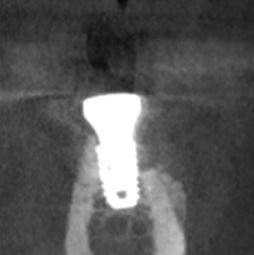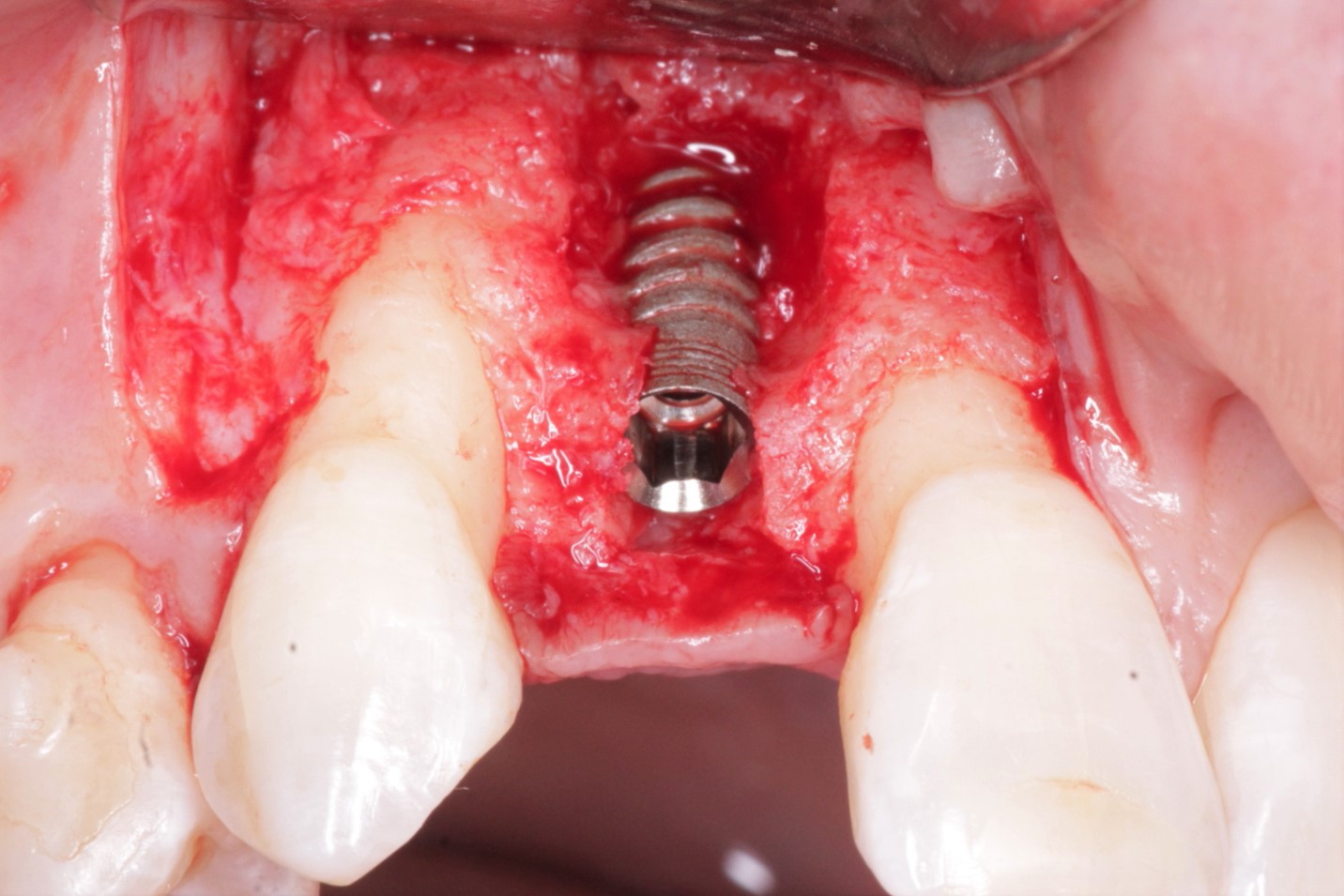BruxZir Zirconia Crown to Implant Failures: thoughts?
I have had two recent problems with screw-retained zirconia crowns.
1. BruxZir (Glidwell) crown loosened up after 5 years. I noted a 3mm vertical fracture of the zirconia at the metal margin.
2. I had a similar screw-retained BruxZir (Glidwell) crown de-bond from the metal body of the crown. This case had been inserted for four years.
I am concerned that the technique may be less forgiving than using metal abutments and cemented crowns. Any thoughts on these issues?

11 Comments on BruxZir Zirconia Crown to Implant Failures: thoughts?
New comments are currently closed for this post.
mpedds
7/19/2018
There is lots of research out there about the survival rates of all ceramic crowns on posterior teeth/implants. Last one I read says 5 year survival rate of 63%. Something to think about when choosing restorative materials. Why not PFM?
Jason Larkin
7/19/2018
I like screwmentable over stock abutment. Stock abutment is beefer inside crown...less debond and shoulder that crown sits on is wider than ti base and the tech doesn't have to squeeze down crown at neck. Pressure over surface area. Just my 2 cents.
Dr. Gerald Rudick
7/19/2018
A history lesson young dental implant practitioners probably don't know........
Fifty one years ago, while sitting at a lecture given by New York dentist Dr. Leonard Linkow at the Hebrew University Dental School in Jerusalem, Israel, where I was a post graduate student in Oral Rehabilitation.......Dr. Linkow showed us how he copied and miniaturized an adjustable furniture leg to act as an antirotational device for the abutment of a dental implant....... the adjustable furniture leg is screwed into the frame of the furniture by using hex driver to screw the leg into the base, and there is a threaded hole in the leg where an adjustable screw is inserted with a foot pad....so in this way the height of the furniture piece can be adjusted up or down.
In the case of a dental implant, the hex is not used to screw the abutment, but simply to keep the abutment stable and prevent turning or twisting.....Linkow applied this principal to the dental implants he designed........but little did he realize, that a younger dentist named Dr. Gerry Niznick, saw this idea, and being a track star...ran to the patent office and got worldwide patents and was able to hold the implant industry hostage for 20 years if any implant manufacturer wanted to use the internal hex design, without paying him a royalty......... this patent no longer controls the industry, it is over....... but when you look at the crowns displaced in this posting.... from an engineering point of view, it makes no sense that a little tiny hex should control and contain the antirotation of a gigantic crown under a lot of stress and force load......they do get loose!!!!
You younger guys, it is time for you to design a better anti-rotational system.
The Adin Dental Implant system has come up with a "Close Fit Connection" that does restrict loosening....worth trying, and mention my name ( Gerry Rudick ) when you contact the owner Ami Hantman... he will advise you well.
Dok
7/19/2018
Case 1-- Chances are the crown loosening had nothing to do with the vertical fracture you visualized after removing the crown/abutment. Stress cracks occur with all prosthetic material types and screws loosen in any system.
Case 2-- The debonding you experienced is a probably a crown/abutment production mistake by the lab and not a general negative characterization of this type of implant prosthesis.
MightyMart
7/21/2018
A Glidwell rep called yesterday in response to this post. She explained that the lab now uses a longer metal inserts, 5mm vs 3mm. This change took place two years ago, and they feel that the de-bonding issues should be resolved.
Rsachsdds
7/19/2018
I just had the same problem with two individual Glidewell Brx-Zir screw down ti-base crowns on teeth #4 and #5 (upper right first and second premolars). Vertical fracture in the ceramic.
Crown loose, abutment secure. Noticed this when I removed the crowns. First #4 then #5.
Not reassuring at all.
MICHAEL KULWIEC
7/19/2018
I suggest you consider the Smileloc abutment system from RODO. It eliminates both cement and occlusal screws. The product has undergone 4 years of clinical trails at UCLA, and is proven for single tooth, bridges and All on Four Hybrids. My lab has high experience with Smileloc, so please contact me if you would like more information. Smileloc currently is compatible with Straumann and Nobel implants. Michael Kulwiec, CDT www.dentalmasters.com
Dale Gerke - BDS, BScDent
7/20/2018
Firstly it has to be said that implant crowns do become loose – I estimate about 0.5% to 1% over a 5 to 15 year duration. No big deal – just unscrew, clean them and screw them back in. If they come loose again then replace the screw after the second or third time. I should mention that in almost all cases that this has happened to me, it has involved patients who are aggressive bruxers. Night guards have helped prevent recurrent issues.
One major advantage of implant crowns is that they are retrievable. In other words, if you need to, you can remove them, repair them if needed, and then put them back in place.
Unfortunately this is not very easy to do in the case of cemented crowns. So why would you want to remove one major advantage of implant crowns by cementing them?
Further, it is well reported that excess cement between the crown and abutment can/will cause inflammation and ultimately lead to peri-implantitis. I cannot understand how anyone can be confident that there is no excess cement under the gingival crest if one cements an implant crown onto an abutment (in situ) if the junction is considerably sub-gingival.
For these reasons I have never cemented an implant crown in place over 25 years of providing implants/crowns. I have always managed to make them screw retained (and never had to use buccal access). Of course this has become exceptionally easy nowadays due to “re-directional†screws and abutments. Further, preoperative CAD/CAM design and surgical guides now allow you to plan implant placement in advance and consider the prosthodontic requirements before a final decision is made in regards to orientation of the implant.
As mentioned by others above, cracks can develop in porcelain crowns but that does not necessarily mean there is a terminal problem. Personally I have had virtually no problems with porcelain crowns cemented to tailor made metal abutments on posterior teeth (screw retained crowns). It is not unheard of that crowns will detach from the metal abutment to which they have been cemented (albeit it is not as frequent as the screw becoming loose). If the crown you are reporting has detached from the metal core (not the abutment) then you might want to discuss this with your laboratory since I would not think this should happen (but I am not familiar with the facts of the matter).
I agree with another writer above, that PFM is a logical way to go with implant crowns. Unfortunately at this time there are not really any great PFM systems to use. There are several cast abutment type systems but most technicians will tell you these have problems (which I have had bitter experiences with). This is mainly to do with the milled fixture surface (either distorting or oxidising during firing or casting).
I think some type of PFM system is the best way for the profession to move forward in regards to implant crowns. It maybe that a good option would be to have your laboratory mill respective abutments (CAD/CAM design) from Chrome/Cobalt (of a lower strength than the titanium implant). This might: overcome the oxidation issues, not distort, be relatively cheap, and be sacrificial in comparison to the implant if over stressed. The advantage is that there would be no cement margin or gap to cause problems at any time after crown placement.
Dr.Gerald Rudick
7/21/2018
I have commented above on the short comings of the internal hex system and the all too often screw loosening problems. When it is a screw- retained crown, it is simple to remove the screw, irrigate the implant, crown, and screw the Dakin's solution sodium hypochloride or Peridex and replace....... I have published an article in 2015 in the now discontinued online journal Implant News and Views ( which I believe is still available) to deal with cement retained crowns where the abutment has loosened.
Following my method, the crown will not be damaged, can be easily removed, and the implant abutment tightened, and the crown recemented ...... all without damage.
Very simply...... put a metal matrix band around the crown, tighten securely, and with a crown and bridge remover, tap on the matrix band holder, and the crown will left off....providing you have used temporary or a weak cement....should work.....give it a try, your patient will appreciate you even more.
If you cannot access Implant New & Views, please send me an email, and I will send you the article
drfills
7/26/2018
Some of these issues, I was told by Nobel were due to lab microscopically and better fits stay longer.
bio-dent laboratory
7/8/2019
The BruxZir® Solid Zirconia Full-Arch Implant Prosthesis offers a fixed, all-zirconia implant solution for edentulous patients desiring a more durable and esthetic replacement for removable dentures. Constructed from 100% BruxZir Solid Zirconia, this full-arch restoration dramatically improves speech and chewing function, attaches to implants via titanium connections, and avoids the chips, stains and fractures known to compromise acrylic hybrid dentures.

















